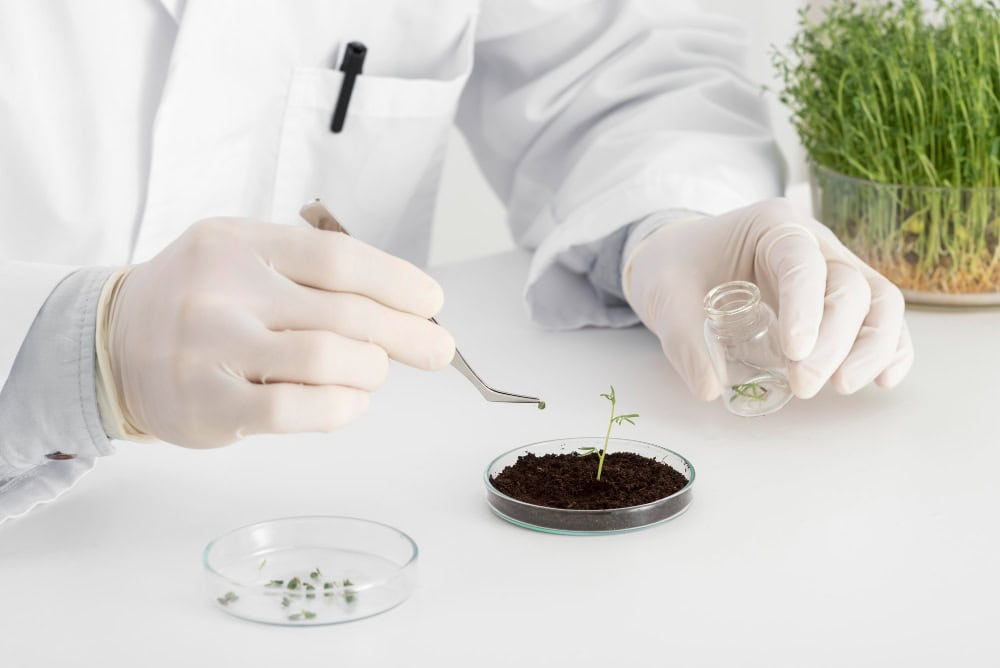
The foundation of a healthy and thriving lawn is rooted in the quality of the soil beneath it. Just like any plant, grass needs the right environment to grow strong and vibrant, and the key to achieving this starts with understanding and managing the soil’s health. Soil testing is an essential first step in assessing soil health, as it provides valuable insights into its composition, nutrient levels, and overall condition. At Erbert Lawns, we emphasize the importance of soil testing to understand your lawn’s specific needs, improve soil quality, and achieve the perfect balance for optimal grass growth.
Key Takeaways
- Soil testing uncovers nutrient deficiencies and pH imbalances.
- Healthy soil reduces the need for excessive watering and fertilization.
- Addressing soil quality improves lawn health and sustainability.
- Erbert Lawns provides expert soil testing and tailored solutions.
Why Soil Testing is Important
Soil testing is a crucial step for anyone who wants to improve or maintain a healthy lawn. Often, grass and plants fail to thrive due to poor soil conditions, which can include nutrient deficiencies, imbalances in pH, or the presence of harmful substances. By testing the soil, you can identify any issues and take proactive steps to correct them. A soil test will tell you:
- Nutrient Levels – It reveals the levels of essential nutrients like nitrogen, phosphorus, potassium, calcium, and magnesium in your soil.
- pH Levels – The test indicates the soil’s acidity or alkalinity, which directly affects nutrient availability to plants.
- Soil Composition – It shows the balance of sand, silt, and clay, giving you an understanding of the soil’s texture.
- Soil Organic Matter – It can provide insight into the organic matter content, which is vital for soil structure and nutrient retention.
With this information, you can make informed decisions about how to improve your soil, ensuring it supports a healthy and lush lawn.
How to Test Your Soil
Soil testing can be done at home with a simple kit or through professional laboratory services, and it is an essential step in maintaining a healthy lawn. Proper soil testing can significantly enhance the effectiveness of your lawn care service, ensuring optimal growth and vibrant greenery. Here’s a step-by-step guide to testing your soil:
-
Choose Your Testing Method:
- DIY Kits: You can purchase soil test kits from garden centers or online. These kits usually come with instructions on how to take soil samples and analyze them for key nutrients and pH levels.
- Professional Lab Testing: For a more detailed and accurate analysis, consider sending a soil sample to a local agricultural extension service or professional lab. These labs provide comprehensive reports on nutrient deficiencies, pH imbalances, and recommendations for amendments.
-
Collect the Soil Sample:
- Take samples from different spots across your lawn (especially if you have problem areas). Avoid collecting soil from areas with obvious issues like pet waste, plant debris, or fertilizer spots.
- Use a clean trowel or soil auger to gather samples to a depth of about 4-6 inches.
- Place the samples in a clean container and mix them to create a composite sample.
-
Send the Sample or Test It Yourself:
- If you’re using a lab, follow their instructions for sending the sample, and wait for the results.
- If you’re using a DIY kit, follow the instructions for testing and note down the results.
-
Interpret the Results:
Once you receive your test results, take note of the nutrient levels, pH levels, and other data provided. The results typically come with recommendations for improving your soil, such as what fertilizers or amendments to add.
By incorporating soil testing into your lawn care routine, you can make informed decisions about fertilization, aeration, and other essential treatments, ultimately improving the quality and health of your lawn. For professional assistance, consider partnering with a reliable lawn care service to implement the recommendations effectively.
Managing Soil pH for Lawn Health
One of the most critical aspects of boosting lawn soil health that directly affects lawn growth is soil pH. The pH level measures the soil’s acidity or alkalinity, and it plays a significant role in nutrient availability. Most grass species thrive in slightly acidic soil with a pH between 6.0 and 7.0. If the soil is too acidic (below 6.0) or too alkaline (above 7.0), grass may struggle to absorb the nutrients it needs, leading to poor growth or even lawn death.
How to Adjust Soil pH:
-
If the Soil is Too Acidic:
- Add Lime: If your soil pH is below 6.0, it is considered acidic, a condition known as soil acidification. This can negatively impact plant growth by reducing nutrient availability. Adding lime to your soil is a common solution to address this issue. Lime, usually in the form of agricultural lime (calcium carbonate), raises the pH, neutralizes soil acidity, and makes the soil more alkaline, creating a healthier environment for plants to thrive.
- Application Rate: The amount of lime needed depends on your soil’s current pH, the type of soil, and the grass you’re growing. A soil test will help determine the exact amount needed.
-
If the Soil is Too Alkaline:
- Add Sulfur: If your soil pH is above 7.0, it is too alkaline. Adding sulfur or other acidifying agents (such as aluminum sulfate) can lower the pH and make the soil more acidic.
- Application Rate: Similar to lime, the amount of sulfur needed depends on the severity of the alkalinity. Soil testing is crucial to avoid over-application.
Note: When adjusting pH, it’s important to make gradual changes. Large, sudden shifts in pH can stress plants, so always follow the recommendations provided by your soil test report.
Improving Soil Quality for a Healthier Lawn
In addition to managing pH, improving overall soil quality is crucial for long-term lawn health. Here are a few strategies to enhance your plant nutrition, soil’s fertility and structure:
- Add Organic Matter: Organic materials like compost, aged manure, and grass clippings add essential nutrients to the soil. They also improve soil structure by increasing water retention and drainage, as well as enhancing microbial activity. Adding organic matter can help build a healthy, well-balanced soil ecosystem that supports grass growth.
- Aeration: Over time, soil can become compacted, especially in high-traffic areas. Compacted soil reduces water infiltration and root penetration, making it difficult for grass to grow. Aerating your lawn by using a lawn aerator (or hiring a professional) creates holes in the soil, allowing air, water, and nutrients to reach the roots more effectively. Aerating is particularly beneficial for clay-heavy soils.
- Fertilization: Once you know your soil’s nutrient levels from the soil test, you can apply fertilizers that address any deficiencies. Use balanced fertilizers that provide a mix of nitrogen (N), phosphorus (P), and potassium (K), or opt for specific nutrients if your soil is lacking in one particular area. Be cautious with the amount you apply, as over-fertilizing can damage the grass and contribute to environmental issues.
- Soil Amendments: Depending on your soil test results, you may need to add other soil amendments, such as gypsum for clay-heavy soils or sand to improve drainage in loamy soils.
- Mulching: Mulch not only conserves moisture but also slowly breaks down and adds organic matter to the soil. Applying a thin layer of organic mulch, such as shredded leaves or bark, can enhance the quality of the soil and promote healthy grass growth.
Conclusion
Healthy soil is the foundation of a beautiful, thriving lawn. By investing in soil testing and addressing nutrient and pH imbalances, you set the stage for long-term success. At Erbert Lawns, we specialise in soil health and provide tailored solutions to ensure your lawn looks its best all year round. Contact Erbert Lawns today to schedule your soil testing and take the first step toward a greener, healthier lawn.
FAQs
Why is soil testing important for my lawn?
Soil testing identifies nutrient deficiencies and pH imbalances, helping you optimise lawn care efforts.
How often should I test my soil?
Testing once a year, ideally during spring or autumn, is recommended to maintain optimal soil health.
Can I perform soil testing myself?
Yes, with a quality soil testing kit. However, professional services provide more detailed and accurate results.
How do I know if my soil needs lime or sulfur?
Soil test results will indicate whether your pH is too high or too low, guiding the application of lime or sulfur.
Does Erbert Lawns offer soil testing services?
Absolutely. We provide professional soil testing and customised lawn care plans.











